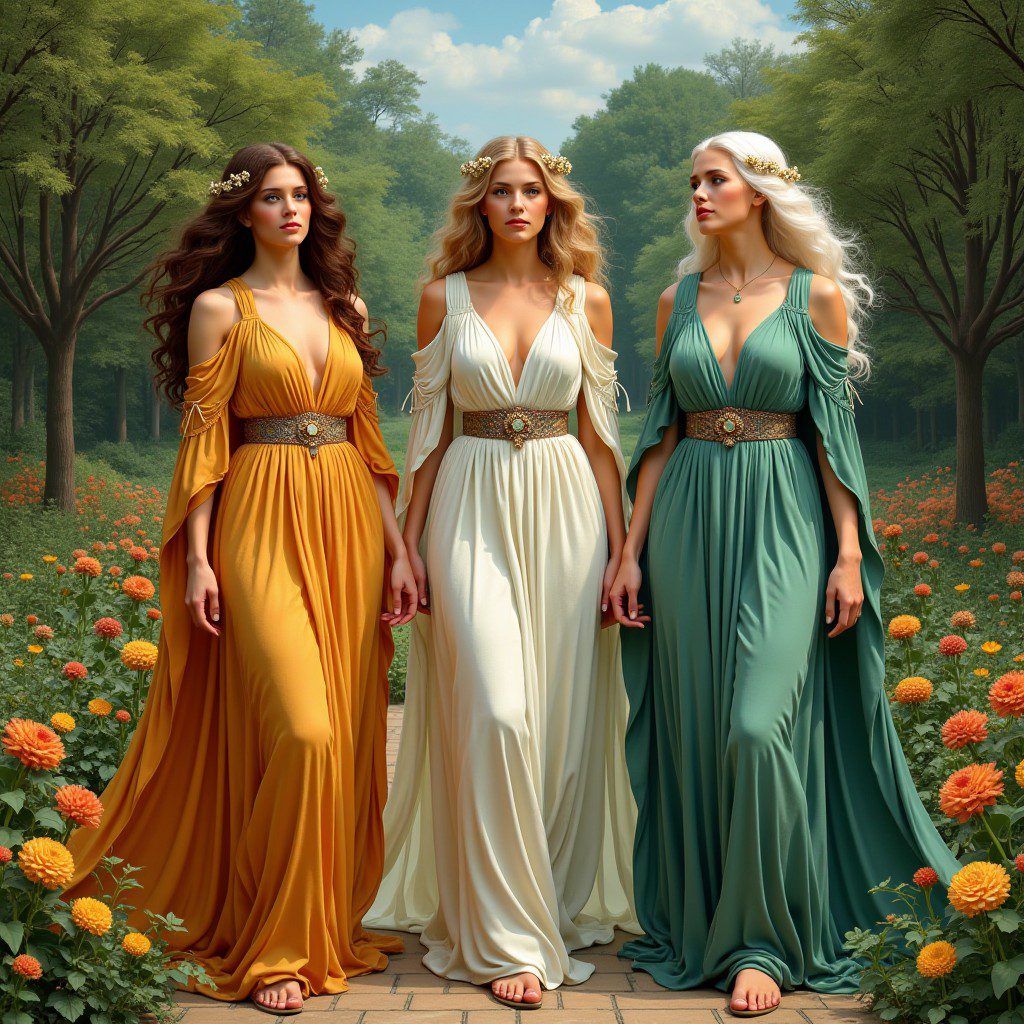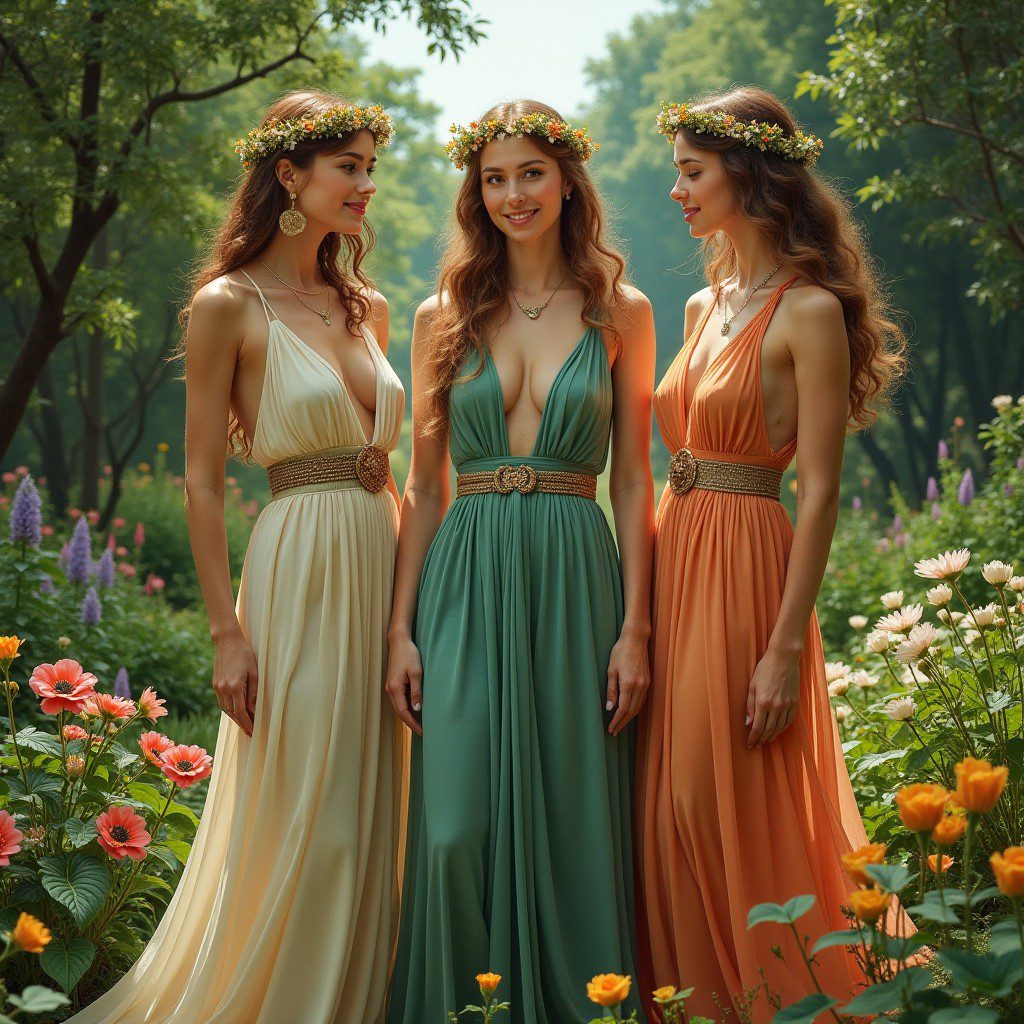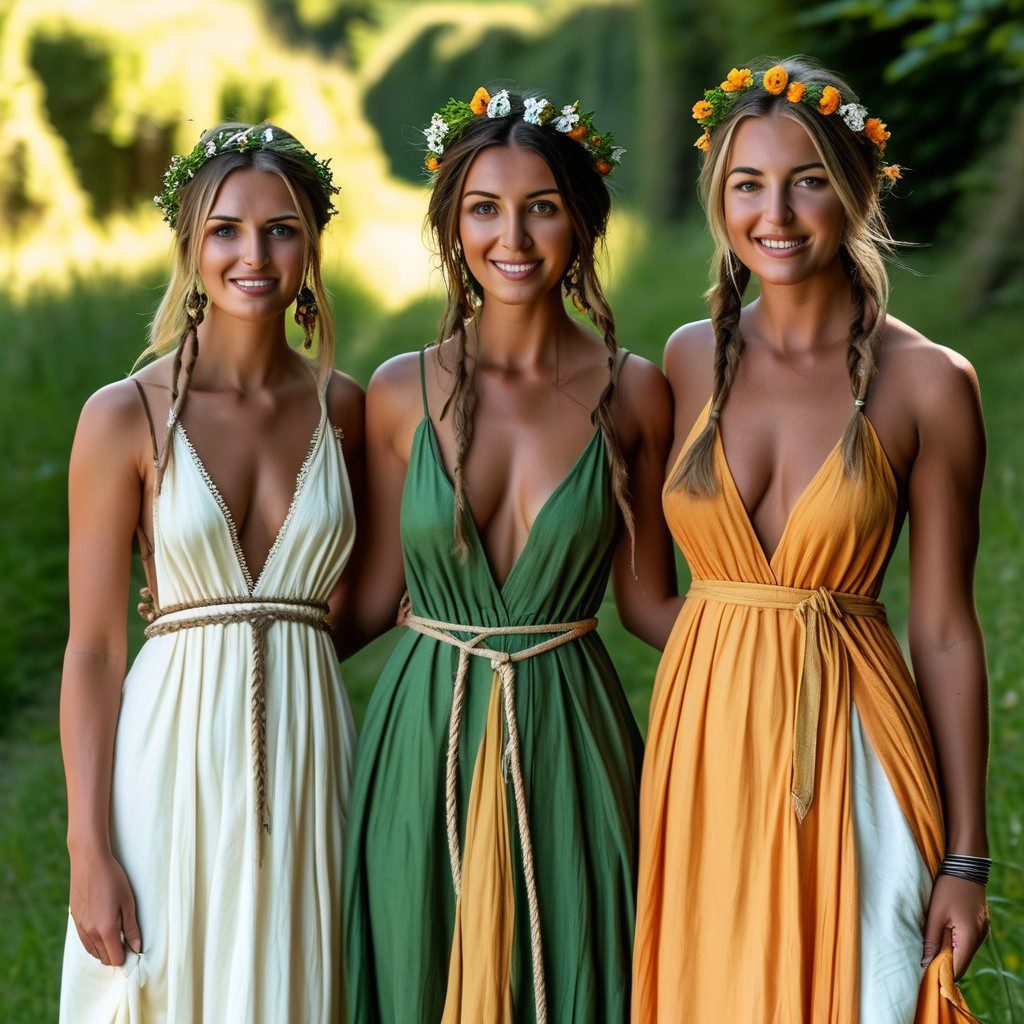The Horae: Goddesses of the Seasons and Guardians of Cosmic Order

In Greek mythology, the Horae (or Horai, meaning “hours” or “seasons”) were goddesses who personified natural order, time, and the seasons. Originally associated with the progression of nature and the changing of the seasons, their role later expanded to include broader concepts of order, law, and justice in human society. The Horae served as the embodiment of both the natural cycles and the social order that governed the lives of gods and mortals alike.
While their function varied depending on the era and region of Greece, the Horae were consistently depicted as powerful but harmonious figures who maintained the balance of both the natural world and the moral universe. These goddesses are a key part of the Greek understanding of time and order, reflecting how deeply intertwined natural cycles were with the laws that governed human life.
Origins and Cultural History of the Horae
The Horae were traditionally believed to be the daughters of Zeus, the king of the gods, and Themis, the Titaness of divine law and order. As daughters of Themis, their primary role was to uphold cosmic balance, which included both the regularity of the seasons and the justice that maintained peace among humans and gods. In Hesiod’s Theogony, they are presented as three sisters who ensure the timely progression of nature and the stability of human institutions.
In early myths, the Horae were closely connected with agriculture, representing the natural cycles that allowed crops to grow and thrive. The Greeks’ reliance on the rhythms of the natural world—particularly for agriculture—meant that the Horae were venerated as deities of fertility and growth, helping to guarantee prosperity and abundance through the orderly flow of the seasons.
Later, their responsibilities grew to encompass societal order, especially justice (dike), lawfulness (eunomia), and peace (eirene). This shift reflected the Greeks’ view that just as the natural world followed a predictable cycle, so too must human society adhere to laws and fairness. The Horae thus became seen as essential figures in both the cosmic and moral order.
The Three Classical Horae

In most accounts, the Horae are depicted as a triad of goddesses. Each sister represents a specific aspect of order, both in the natural world and in human affairs:
1. Eunomia (Good Order)
Eunomia personifies lawfulness and good governance. She is associated with the legal systems and institutions that maintain peace and stability in society. Her role is to ensure that laws are fair and that rulers govern with wisdom and justice. As the embodiment of lawful order, Eunomia represents the structure that allows civilization to thrive.
In her connection with nature, Eunomia also reflects the orderly progression of the seasons and the cycles of growth, ensuring that everything happens at its proper time. In this way, she balances the natural world’s rhythms with the social structures of human civilization.
2. Dike (Justice)
Dike represents justice and fairness, particularly as it applies to human actions and behavior. As a goddess, she presides over the moral law that governs both gods and mortals, making sure that justice is served and that wrongdoers are punished. Dike is often depicted holding a set of scales, symbolizing the balance of justice.
Dike’s presence in Greek mythology highlights the importance of moral law, which was considered just as important as natural law. She ensures that those who act unjustly are held accountable, reinforcing the Greek belief that justice is an inherent part of the universe’s order.
3. Eirene (Peace)
Eirene is the goddess of peace, prosperity, and harmony. Her role is to maintain the tranquility that comes when laws are followed and justice is upheld. As a bringer of peace, Eirene was particularly venerated during times of war, when her presence was seen as a promise of future harmony.


In terms of natural cycles, Eirene is often linked to the fruits of the earth that follow a period of growth and harvest. She represents the peace that comes with abundance and prosperity, symbolizing the rewards of a well-ordered and just society.
The Horae and the Seasons
While the Horae are primarily known as goddesses of order and justice, their earlier roles as goddesses of the seasons and agriculture were crucial in the ancient world. The Greeks depended on the natural cycle of the seasons for their survival, and the Horae were revered for their ability to regulate these cycles.
In early traditions, the Horae were seen as the personifications of the three key agricultural seasons:
- Thallo (Spring)
Thallo represents spring and the blooming of plants. As the goddess of new growth, she is associated with the planting season and the beginning of the agricultural cycle. Her name means “to blossom,” emphasizing her role in the rebirth and renewal of nature. - Auxo (Summer)
Auxo, meaning “growth” or “increase,” embodies the summer season, during which crops grow and flourish. She ensures that plants mature properly, preparing them for the harvest in the coming months. - Carpo (Autumn/Fruit)
Carpo is the goddess of autumn and harvest. Her name translates to “fruit” or “harvest,” and she represents the abundance of the earth during the harvest season. Her role is to ensure that the earth’s bounty is collected and stored for the winter.
These seasonal Horae show how closely the Greeks tied natural cycles to divine beings. The predictable progression of the seasons was seen as part of the divine order, overseen by these goddesses to ensure that life could continue in harmony with nature.
The Horae in Greek Mythology
Although the Horae do not appear as frequently in the major myths of Greek mythology as gods like Zeus or Athena, they still play an important role in several key stories, often representing the natural and moral order of the universe.
1. The Horae and the Olympian Gods
The Horae are most commonly associated with Zeus and Hera, as their role as enforcers of divine law makes them essential allies of the ruling gods. In some myths, the Horae are depicted as the gatekeepers of Olympus, controlling access to the home of the gods. They ensure that only those who are worthy may enter and that divine law is upheld within the realm of the gods.
2. The Horae and Persephone
The Horae also play a role in the myth of Persephone, the daughter of Demeter and Zeus. When Persephone is abducted by Hades and taken to the underworld, the natural order is thrown into chaos. As goddesses of the seasons, the Horae are directly impacted by Persephone’s absence, as the earth no longer produces crops, and the natural cycles are disrupted. When Persephone returns to the surface world for part of the year, the Horae welcome her back, signaling the return of spring and the resumption of the earth’s fertility.
3. The Horae and Athena
In some myths, the Horae are closely connected to Athena, the goddess of wisdom and war. As patrons of justice and order, the Horae reflect the values that Athena upholds—wise governance, lawful behavior, and the maintenance of peace through fairness. Their partnership with Athena underscores their role in supporting both divine and mortal rule.
Strengths and Weaknesses of the Horae
Strengths:
- Embodiment of Order: The Horae represent both the natural and social order, ensuring that the universe functions according to divine law. Their influence over time, seasons, and justice makes them key figures in maintaining balance.
- Balance Between Nature and Civilization: The Horae embody the idea that the cycles of nature and the laws of civilization are deeply connected. Their ability to oversee both agriculture and justice reflects their importance to both the natural world and human society.
- Peace and Prosperity: The Horae’s connection to peace, law, and justice makes them symbols of harmony. Their presence ensures that chaos is kept at bay and that both nature and society can flourish.
- Guardians of the Seasons: As early goddesses of the seasons, the Horae ensure the orderly progression of time, allowing life to flourish in accordance with natural rhythms.
Weaknesses:
- Limited Individuality: The Horae are often seen more as collective forces than as individual deities. While they represent important concepts, their lack of distinct personalities makes them less prominent in mythology than other gods.
- Dependence on Cosmic Order: The Horae’s power comes from their connection to the natural and social order. When that order is disrupted, as in the case of Persephone’s abduction, their influence weakens, showing that they are bound to the cycles they oversee.
- Secondary Roles in Myths: While the Horae are important in their cosmic functions, they rarely play central roles in mythological stories. Their influence is more often felt in the background, supporting the actions of other gods and maintaining balance.
The Horae in Modern Media
Though the Horae are not as well-known in popular culture as other figures from Greek mythology, their presence can still be found in modern literature, art, and games that draw upon the themes of natural cycles and order.
- Literature: The Horae appear in adaptations of Greek mythology, such as in Rick Riordan’s Heroes of Olympus series, where they are re-imagined as goddesses who help maintain the natural order.
- Games: In video games that feature Greek mythology, such as Hades or Assassin’s Creed Odyssey, the Horae might be referenced as part of the pantheon overseeing time, seasons, or divine order, though they
